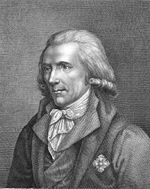論摩擦激起的熱源
《論摩擦激起的熱源》[1](英語:An Experimental Enquiry Concerning the Source of the Heat which is Excited by Friction[2],也稱為倫福德的炮筒鏜孔摩擦生熱實驗[3])(1798),是由倫福德最早發表在《自然科學會報》[4] 上的一篇論文,這篇論文向當時的熱質理論拋出了一個重大難題,並引發了19世紀的熱力學革命。

背景
編輯熱質說是一種曾用來解釋熱的物理現象的理論。此理論認為熱是一種稱為「熱質」(caloric)的流體物質,熱質會由溫度高的物體流到溫度低的物體,也可以穿過固體或液體的孔隙中。
倫福德是熱質說的反對者,他在當時經過研究後認為,所有的氣體和液體都是絕對不導熱的。由於他的觀點過於超前,不被當時的科學界認可,並遭到約翰·道爾頓[4]和約翰·萊斯利[5]等人的批評。
由於倫福德受天主教的目的論論證[6]影響很深,他可能希望授予水某種特殊的導熱權[4]。
儘管倫福德試圖將熱量與運動建立聯繫,不過沒有證據表明他研究過分子運動論或是活力理論。
在這篇論文中,倫福德承認他曾認為熱是運動過程的一部分[7]。這與弗蘭西斯·培根[8]、羅伯特·波義耳[9]、羅伯特·胡克[10]、約翰·洛克[11]和亨利·卡文迪什[12]過去的一些觀點不謀而合。
實驗
編輯倫福德觀察了慕尼黑兵工廠加農炮鏜孔過程中摩擦生熱的一些過程後進行了這個實驗。他將一個加農炮筒浸入水中,並準備了一種特別鈍的鏜鑽機。在這種情況下他不斷的用鑽機摩擦炮筒,鑽出大量高熱量的碎屑,並發現大概兩個半小時後水沸騰了[1][2]。但問題在於,通過比較炮筒的比熱容可以發現,這個過程中炮筒並沒有損失能將水加熱水平質量的物質來加熱水,這與熱質說的結論不符。
倫福德認為,看似無限的熱量生成與熱質理論不吻合。他認為在這個過程中唯一進行的操作只是運動和摩擦,因此他認為熱不可能是物質而有可能是運動。
倫福德甚至粗略估計出產生1開爾文的熱需要5.5焦耳的機械能,但他並未嘗試進一步量化所產生的熱量或測量熱量的機械當量[3]。
影響
編輯大多數當時的科學家認為熱質說的確存在不完善之處,可以通過進一步完善該理論來適應該實驗的結果,這一派科學家包括威廉·亨利[13]和托馬斯·湯普森。此外,湯普森[14]、永斯·貝采利烏斯和安東尼·塞瑟發現了電似乎也能由摩擦「無限產生」。在當時沒有一個科學家願意承認電不是一種流體。
最終,倫福德聲稱的「無限生成」的熱量被認為是該研究的魯莽外推。查爾斯·海爾戴特批評,倫福德的實驗可重複性十分差[15],整個實驗看起來有一些偏見[4]。
然而,倫福德的實驗給了焦耳靈感,1840年代焦耳再次精確的做了一次本實驗,這次他用上了測定熱量的儀器,最終在熱質說的基礎上建立了分子運動論這門科學。
參考文獻
編輯- ^ 1.0 1.1 胡承正. 吉正霞 , 編. 热力学与统计物理学 (PDF) 第一版. 北京: 科學出版社. 2009-06: 1-2 [2020-07-24]. ISBN 9787030246042. (原始內容存檔 (PDF)於2020-07-24).
- ^ 2.0 2.1 Benjamin Count of Rumford (1798) "An inquiry concerning the source of the heat which is excited by friction," (頁面存檔備份,存於網際網路檔案館) Philosophical Transactions of the Royal Society of London, 88 : 80–102. doi:10.1098/rstl.1798.0006
- ^ 3.0 3.1 劉德磊、曾莉莉、屈志偉. 经典热力学发展概述. 《廣州化工》. 2012年, (2): 26–28 [2020-07-24]. (原始內容存檔於2020-07-24).
- ^ 4.0 4.1 4.2 4.3 Cardwell, D.S.L. From Watt to Clausius: The Rise of Thermodynamics in the Early Industrial Age. Heinemann: London. 1971: 99-102. ISBN 0-435-54150-1.
- ^ Leslie, J. An Experimental Enquiry into the Nature and Propagation of Heat. London. 1804.
- ^ Rumford (1804) "An enquiry concerning the nature of heat and the mode of its communication (頁面存檔備份,存於網際網路檔案館)" Philosophical Transactions of the Royal Society p.77
- ^ From p. 100 of Rumford's paper of 1798: "Before I finish this paper, I would beg leave to observe, that although, in treating the subject I have endeavoured to investigate, I have made no mention of the names of those who have gone over the same ground before me, nor of the success of their labours; this omission has not been owing to any want of respect for my predecessors, but was merely to avoid prolixity, and to be more at liberty to pursue, without interruption, the natural train of my own ideas."
- ^ In his Novum Organum (1620), Francis Bacon concludes that heat is the motion of the particles composing matter. In Francis Bacon, Novum Organum (London, England: William Pickering, 1850), from page 164: (頁面存檔備份,存於網際網路檔案館) " … Heat appears to be Motion." From p. 165: (頁面存檔備份,存於網際網路檔案館) " … the very essence of Heat, or the Substantial self of Heat, is motion and nothing else, … " From p. 168: (頁面存檔備份,存於網際網路檔案館) " … Heat is not a uniform Expansive Motion of the whole, but of the small particles of the body; … "
- ^ "Of the mechanical origin of heat and cold" in: Robert Boyle, Experiments, Notes, &c. About the Mechanical Origine or Production of Divers Particular Qualities: … (London, England: E. Flesher (printer), 1675). At the conclusion of Experiment VI, Boyle notes that if a nail is driven completely into a piece of wood, then further blows with the hammer cause it to become hot as the hammer's force is transformed into random motion of the nail's atoms. From pp. 61-62: " … the impulse given by the stroke, being unable either to drive the nail further on, or destroy its interness [i.e., entireness, integrity], must be spent in making various vehement and intestine commotion of the parts among themselves, and in such an one we formerly observed the nature of heat to consist."
- ^ "Lectures of Light" (May 1681) in: Robert Hooke with R. Waller, ed., The Posthumous Works of Robert Hooke … (London, England: Samuel Smith and Benjamin Walford, 1705). From page 116: (頁面存檔備份,存於網際網路檔案館) "Now Heat, as I shall afterward prove, is nothing but the internal Motion of the Particles of [a] Body; and the hotter a Body is, the more violently are the Particles moved, … "
- ^ Sometime during the period 1698-1704, John Locke wrote his book Elements of Natural Philosophy, which was first published in 1720: John Locke with Pierre Des Maizeaux, ed., A Collection of Several Pieces of Mr. John Locke, Never Before Printed, Or Not Extant in His Works (London, England: R. Francklin, 1720). From p. 224: (頁面存檔備份,存於網際網路檔案館) "Heat, is a very brisk agitation of the insensible parts of the object, which produces in us that sensation, from whence we denominate the object hot: so what in our sensation is heat, in the object is nothing but motion. This appears by the way, whereby heat is produc'd: for we see that the rubbing of a brass-nail upon a board, will make it very hot; and the axle-trees of carts and coaches are often hot, and sometimes to a degree, that it sets them on fire, by rubbing of the nave of the wheel upon it."
- ^ Henry Cavendish (1783) "Observations on Mr. Hutchins's experiments for determining the degree of cold at which quicksilver freezes," Philosophical Transactions of the Royal Society of London, 73 : 303-328. From the footnote continued on p. 313: (頁面存檔備份,存於網際網路檔案館) " … I think Sir Isaac Newton's opinion, that heat consists in the internal motion of the particles of bodies, much the most probable … "
- ^ Henry, William. A review of some experiments which have been supposed to disprove the materiality of heat. Manchester Memoirs. 1802, (V): 603.
- ^ Thomson, T. "Caloric", Supplement on Chemistry, Encyclopædia Britannica, 3rd ed.
- ^ Haldat, C.N.A (1810) "Inquiries concerning the heat produced by friction", Journal de Physique lxv, p.213